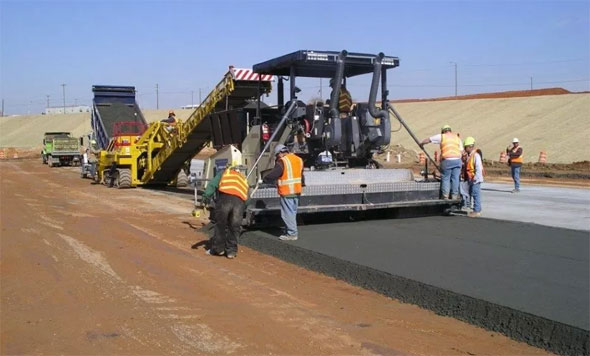Benefits of Roller Compacted Concrete
- Concrete Cost Estimator
- Concrete Continuous Footing
- Landscape Bidding and Estimating
- Construction Cost Estimating
- Concrete and steel cost estimation
- Construction Cost Estimate Breakdown
- Construction Estimating Worksheet
- Home Construction Cost Estimate
- Estimate Pricing Sheet
- Sheet for General Contractor
- Construction Cost Estimate
- Labor Materials Cost Estimator
- Masonry Estimating Sheet
- Sheet for Building Contractor
- Construction Schedule Bar chart
- General Cost Estimator Sheet
- General Construction Estimate
- Building and Road Estimating Sheet
- Detailed expense estimates
- Door and Window Takeoff Sheet
- General Construction Cost Estimating Sheet

Roller Compacted Concrete (RCC) makes a sea change in the construction methods of dams and other structures. Roller Compacted Concrete stands for the concrete that is compacted with roller compaction technique.
The concrete mixture that is utilized for construction should be retained in an unhardened condition to provide the support to the roller compaction. So, roller compacted concrete is different from the traditional concrete mixture with regard to necessary consistency. It means the concrete should be sufficiently dry for resisting the sinking of the roller equipment but at the same time, it should be sufficiently wet to facilitate the proper distribution of binder mortar utilized.
Materials and Mix proportion:
Cement: Cement with lower heat generation is recommended. No special type of cement is essential for RCC.
Admixture: Huge amounts of mineral admixtures should be applied in RCC mixtures to decrease the high temperature of concrete and enhance longevity. Generally, air pulling and water reducing admixtures are found in RCC. Besides, set-retarding admixtures can make the time longer to which the concrete should prevail unhardened.
Aggregates: Usually, the size of aggregates should be under 38 mm (1.5 in). The size of aggregate plays an important role for the degree compaction of small layers but not in thicker layers. If the size of the aggregates is under 75µm, it forms a more cohesive mixture of concrete. If the stress level in the structure is minimum, cohesive concrete can be applied in the interior of structure.
Roller Compacted Concrete Properties:
Strength: They contain the compressive strength and tensile strength results almost similar to the normal concrete, varying from 7 to 13 percent. Similar to the normal concrete, the proportion is based on aggregate type, cement content, age etc.
Elastic Modulus and Poisson’s ratio: RCC mixture includes low elastic modulus, since the heat of hydration produced is proportional to elastic modulus. RCC mixture comprises of low heat of hydration. Poisson’s ratio varies from 0.15 to 0.20.
Creep: Creep of RCC is based on the type of aggregate, water-cement ratio, age of loading and the extent of loading. RCC that contains lower compressive strength and lower elastic modulus, produces high creep. Lean concrete containing large amount of fine aggregate also demonstrates high creep.
Thermal properties: The increase of temperature in RCC is equivalent to the normal concrete mixture and primarily based on the amount and type of cement utilized. All other properties like the specific heat, conductivity and coefficient of thermal expansion are a function of amount of aggregate applied in the mixture.
Benefits:

1. Costs: It can curtail the cost up to 25-50% with regard to traditional concrete mixture.
2. Fast construction: Relating to the regular mass concrete dams, RCC structures are completed in 1 to 2 years ahead of the assigned project duration.
3. Spillways: Generally, in embankment dams spillways are built up in an abutment, but in this technology the spillway is built up in the main structure of dam.
4. Because of the application of leaner concrete mix, cement consumption will be reduced.
5. Because of the application of layer placement method, cost of formwork is decreased.
6. Because of low temperature rise, pipe cooling is not essential.
7. Costs of transportation, placement and compaction of concrete are reduced.
Article Source: engineeringcivil.org
- Application of concrete calculator
- Roofing Calculator can streamline the roof estimating process
- House construction cost calculator
- Engineering column design excel spreadsheet
- Material Estimating Sheet with Excel
- Materials List and Cost Estimate Worksheet
- Concrete Slab Estimating Calculator Sheet
- Common types of foundations for buildings
- Online calculation of construction materials
- Estimating with Excel for the Small Contractor
- Concrete Beam Design Spreadsheet
- Virtual Construction Management app for construction
- Autodesk’s Project Skyscraper
- Reed Construction’s Reed Insight
- Manage your construction project documentation
- Costimator, the popular cost estimating software
- On Center Software for construction professionals
- Free Construction Estimating Software
- Plumbing Calc Pro
- Cost Estimate Worksheet
- HVAC Piping Quantity Takeoff Worksheet
- Construction Estimating Software Sheet
- Estimate Cost Templates
- Construction Punch List
- Construction cost estimating template consisting estimating basic
- Gantt Chart Template for Excel
- Download Civil Engineering Spreadsheets with Verification
- The Building Advisor Estimating and Budgeting Worksheet
- Spreadsheet for design of concrete bridge
- Construction Estimating Software Free








